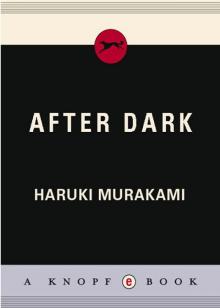- Home
- Haruki Murakami
Absolutely on Music: Conversations With Seiji Ozawa Page 13
Absolutely on Music: Conversations With Seiji Ozawa Read online
Page 13
MURAKAMI: Just the scores? You didn’t listen to them on records?
OZAWA: No, I had never heard them on records. I didn’t have the money to buy records then, and I didn’t even have a machine to play them on.
MURAKAMI: What was it like, reading the scores for the first time?
OZAWA: It was a huge shock for me—until then I never even knew music like that existed. I mean, here we were at Tanglewood, playing Tchaikovsky and Debussy, and meanwhile there’s this guy putting all his energy into studying Mahler. I could feel the blood draining from my face. I had to order my own copies right then and there. After that, I started reading Mahler like crazy—the First, the Second, the Fifth.
MURAKAMI: Did you enjoy just reading the scores?
OZAWA: Oh, tremendously. I mean, it was the first time in my life I had ever seen anything like them. To think there were scores like this!
MURAKAMI: Was it a completely different world from the music you had been playing until then?
OZAWA: First of all, I was amazed that there was someone who knew how to use an orchestra so well. It was extreme—his marvelous ability to put every component of the orchestra to use. And from the orchestra’s point of view, the Mahler symphonies are the most challenging pieces ever.
MURAKAMI: So when was the first time you actually heard, with your own ears, the sound of an orchestra playing Mahler—was that with Bernstein?
OZAWA: Yes, the first time I ever heard Mahler was as Bernstein’s assistant in New York.
MURAKAMI: What was it like for you, hearing the real thing for the first time?
OZAWA: It was a complete shock. At the same time, I felt overjoyed that I could be right there with him, in that time and place, when Bernstein was, quite literally, pioneering this kind of music. So I also did Mahler as soon as I got to Toronto. Then I could do it myself! And with the San Francisco Symphony, too, I played almost all of Mahler’s symphonies.
MURAKAMI: What kind of response did you get from the audiences?
OZAWA: Good, I think. By then, Mahler was, well, not exactly popular—but among the kind of people who come to listen to symphonies, Mahler was getting a lot of attention.
MURAKAMI: But Mahler symphonies are hard work—not just to perform but to listen to!
OZAWA: True, but by then he was popular enough. It was already starting, thanks in large part to Bernstein’s efforts. He put a huge amount of energy into getting the people of the world to listen to Mahler.
MURAKAMI: But still, for a long time, Mahler’s music was not listened to very widely. Why do think that was?
OZAWA: Hmm, I wonder…
MURAKAMI: First you’ve got Wagner, then you go from Brahms to Richard Strauss, which more or less brings the German romantic line to an end. Then you go straight through from Schoenberg’s twelve-tone music to, like, Stravinsky, Bartók, Prokofiev, and Shostakovich, and that’s more or less how the history of music flows, without much room to squeeze in Mahler or Bruckner. At least that’s how it was for a long time.
OZAWA: True.
MURAKAMI: But in Mahler’s case, you get this miraculous revival a half century after the composer’s death. What’s behind all that?
OZAWA: I suspect it probably started with the orchestra musicians themselves. Once they got a chance to actually play some Mahler, they found they liked it, and that led to the revival. And once the musicians started to think of Mahler as fun to play, the orchestras started vying with each other to perform the music. After Bernstein, orchestras from all over gladly adopted Mahler. Especially in the States, there came a point where you weren’t considered an orchestra if you couldn’t perform Mahler. And not just in America: in Vienna, too, they started playing Mahler like crazy, because, after all, they were Mahler’s home base.
MURAKAMI: Yes, but home base or not, the Vienna Philharmonic didn’t play Mahler for a very long time.
OZAWA: That’s true, they didn’t.
MURAKAMI: Do you think that was mainly because people like Böhm and Karajan didn’t take up the music?
OZAWA: Probably. Böhm especially.
MURAKAMI: Both of them often played, say, Bruckner or Richard Strauss, but they never touched Mahler. Mahler himself was the virtual music director of the Vienna Philharmonic for a long time, but I get the impression that the orchestra was cold toward his music for a very long time.
OZAWA: Yes, but the Vienna Philharmonic plays Mahler beautifully now. The orchestra and the music are really a perfect match. They can lay bare its very essence.
MURAKAMI: Last time we talked about this, you said that when the Berlin Philharmonic played Mahler, Maestro Karajan would often take a pass and hand the baton to you.
OZAWA: That’s true. I conducted the Mahler Eighth in Berlin. I think it might have been the first time the Berlin Philharmonic played that symphony. Maestro Karajan told me to do it. Normally, that’s a piece that the music director would conduct himself.
MURAKAMI: Of course, it’s such a big piece, a major event.
OZAWA: But for some reason, the task came to me, and I remember putting everything I had into it. They put together some wonderful soloists for me. And the chorus, too: it wasn’t just the Berlin chorus, but they called in some top professional groups like the Hamburg Norddeutscher Rundfunk Chorus, and the WDR Radio Choir of Cologne, and made a huge production out of it. It was a truly special event.
MURAKAMI: Well, it’s not the kind of symphony you can perform all the time.
OZAWA: I played it in Tanglewood, and then again in Paris—with the Orchestre National de France, in a place called Sandonie.
The Historical Evolution of Mahler Performance
MURAKAMI: The style used to perform Mahler has changed a great deal, hasn’t it, from the sixties to now?
OZAWA: You could say that various different styles of performance have appeared. I was very fond of Lenny’s Mahler.
MURAKAMI: You can listen to those recordings he did with the New York Philharmonic today, and they’re still fresh. I listen to them fairly often even now.
OZAWA: And Maestro Karajan’s Ninth is just wonderful. He did it very late in his career, but it was great. The finale especially. I remember thinking how well suited the piece was to him.
MURAKAMI: The sound of the orchestra absolutely has to be beautiful and meticulous in that symphony.
OZAWA: Especially the finale. That and the finale of the Bruckner Ninth are really tough, the way they both quietly fade away.
MURAKAMI: You have to make the music of that piece in long units, or else you can’t really scoop out everything it has inside—to put it more or less in terms of the “direction” we talked about before.
OZAWA: Right, right. Any orchestra without those long breaths can’t play it. You could say the same thing about Bruckner.
MURAKAMI: The last Mahler Ninth you did with the Boston Symphony was breathtakingly beautiful, too. The one that’s on DVD.
OZAWA: Because we put real feeling into it. Finally, Mahler appears to be written in this very complex way—and in fact it is written in a way that is very complex for the orchestra—but the essential quality of Mahler’s music is such that (and here, I’m afraid the way I’m putting it will be misunderstood) if you do it with feeling, it’s a fairly simple thing. By “simple” I mean something like the musicality of a folk song, something that everyone can hum. Lately, I’ve come to feel that as long as you capture that quality with truly superior technique and tone color and get the feeling into it, it’s probably going to go well.
MURAKAMI: Hmm, it may be easy to say that, but isn’t it hard to actually do it?
OZAWA: Yes, well, of course it’s hard, but—look, all I want to say is that Mahler’s music looks hard at first sight, and it really is hard, but if you read it closely and deeply, with feeling, it’s not such confusing and inscrutable music after all. It’s got all these layers piled one on top of another, and lots of different elements emerging at the same time, so in effect it sounds complicated.
<
br /> MURAKAMI: You get these completely unrelated motifs—sometimes motifs that move in completely opposite directions—proceeding at the same time, with practically equal emphasis.
OZAWA: And they’ll come very close to each other before moving on. When these things happen, the music sounds complicated. You can study it and still be left confused.
MURAKAMI: And it can be hard for listeners, too, almost schizophrenic, if you try to grasp the overall structure of a piece while you’re listening to it.
OZAWA: That’s true. It’s the same with a later composer like Messiaen. He’ll put in three simple melodies that proceed simultaneously and yet have absolutely nothing to do with one another. You pull out any one part and the thing itself is fairly simple. If you put feeling into it, you can perform it quite simply. Which means, in other words, that a musician performing one part just has to concentrate hard on doing that one part. A musician playing a different part puts just as much energy into that without any relation to the first. Put the two of them together at the same time, and the result is the kind of sound that we’ve been talking about.
MURAKAMI: I see what you’re saying. The other day, for the first time in quite a while, I listened to a Bruno Walter performance of the Titan on a stereo LP, and it seems to me I could scarcely hear the grasp of Mahler’s music, the separation of parts that you just described. Instead, I felt a kind of will to force the whole of Mahler’s symphony into one massive frame, to bring it closer to the structure of a Beethoven symphony. But when you do that, you end up with a slightly different sound than the so-called “Mahler sound.” Listening to the first movement of the Titan, for example, I felt that I was hearing the Beethoven Pastoral. That was the kind of sound that Bruno Walter was producing. But when I listen to your performance of the Titan, the sound is so different. Finally, in Walter’s case, it seems as if the traditional form of German music—something like the sonata form—is ingrained in him at the deepest level.
OZAWA: Uh-huh, for sure, that approach may not be very well suited to Mahler’s music.
MURAKAMI: Of course it’s very good as music, very high quality, and moving to listen to. Walter has his own idea of Mahler’s world, and he constructs it in this very solid way. But I think the sound may be just a little different from what we now look for in Mahler’s music, or what we take to be “Mahleresque.”
OZAWA: In that sense, I think that Lenny’s achievement was absolutely huge. He himself was a composer, so he was able to tell the performers, “Do this part this way. Don’t think about the other parts, just concentrate on your own.” When you perform it like that, the result is very convincing to listeners. It brings out the flow of the orchestra. Those elements were already present in the First Symphony, but they’re even more pronounced from the Second onward.
MURAKAMI: But when I listen to records of Mahler performances from the sixties, I get the sense that the approach you’re describing hadn’t formed yet—the idea that if you forge ahead with the details, then the whole will emerge. Rather, what I think I may be hearing is a tendency to carry the music forward emotionally in a traditional fin-de-siècle Viennese way, accepting chaos as chaos. Isn’t the kind of approach you’re describing a relatively recent phenomenon?
OZAWA: Well, maybe so in terms of performance. But the fact is that Mahler was writing his scores the way I’m talking about. Before Mahler, if you had two motifs going at the same time—theme A and theme B—there was a clear distinction between primary and secondary. In Mahler, though, the two are completely equal. So the musicians who are playing theme A have to put their heart and soul into playing theme A; and the musicians playing theme B have to put their heart and soul into playing theme B—with feeling, with color, everything. It’s the job of the conductor to put it all together so that the two themes proceed simultaneously. This is what you need to do with Mahler’s music because that’s how it’s written—right there in the score.
MURAKAMI: Now, let’s talk about the First Symphony, the Titan. So far, you have made three recordings of it: the first in 1977 with the Boston Symphony, then again with Boston in 1987, and the third in 2000 with the Saito Kinen Orchestra. The three recordings sound completely different from one another.
OZAWA: Oh, really?
MURAKAMI: It’s shocking how different they are.
OZAWA: Hmmm.
MURAKAMI: In the simplest terms, the first Boston performance has a very fresh feel to it overall. It’s a young man’s music that goes straight for the heart. The second Boston performance is terrific, with an added density that only the Boston Symphony could produce. But the newest one, with the Saito Kinen Orchestra, feels absolutely transparent to me—as though you can see every little detail. All the inner voices come clearly to the surface. I really enjoyed comparing the recordings and hearing these differences.
OZAWA: I myself changed, too, over that long a time. I’ve never sat down to do a comparison of the three recordings, but I’m pretty sure you’re right about how they differ.
MURAKAMI: When I listen to Abbado’s recent Mahler performances, I’m sure I feel that same kind of grasp of Mahler that you were talking about before. They give the impression of a very deep and meticulous reading of the score, as though he’s become convinced that the more deeply you burrow into the score itself, the more naturally Mahler is going to emerge. I get the same kind of feeling from a conductor like Gustavo Dudamel. Of course it’s important for the conductor to become emotionally involved with the music, but that’s strictly something that comes later, as a result of the deep study of the score.
OZAWA: Maybe so.
MURAKAMI: But when you listen to Mahler performances from the sixties, say, by someone like Rafael Kubelik, there’s still a sense of compromise, as if the shift from a romantic grounding is not yet complete.
OZAWA: Yes, well, the musicians themselves probably had that sort of mind-set back then. But nowadays the players are changing. That’s what I think. Their mentality has definitely been changing—their perceptions of what their roles are with regard to the whole. Recording techniques have also changed. In the old days, the dominant tendency was to record the overall sound. Things like the orchestra’s overall resonance were important. They tried to capture the whole rather than the details. Most of the recordings made in the sixties and seventies were like that.
MURAKAMI: With digitalization, those tendencies have changed. Mahler is not that interesting to listen to anymore unless you can hear each of the individual instruments.
OZAWA: You’re absolutely right about that. Digital recording made it possible to hear every little detail clearly, and that may have caused performances themselves to change. In the old days, we used to pay a lot of attention to things like how many seconds the reverberation lasted, but nobody talks about that anymore. Now, people aren’t satisfied unless they can hear the details.
MURAKAMI: Maybe the recording technology has a lot to do with it, but you can’t quite hear all those details in the Bernstein performances from the sixties, can you? The impression is more one of the sound of the orchestra en masse. So when you’re listening to those records, emotional elements tend to be given far greater emphasis than the accumulation of details.
OZAWA: That’s what the sound was like at the Manhattan Center, where they did the recording. Now they tend to record in performance halls, right up there on the stage. When they do that, you can hear the same reverberation from the record as you would at a concert.
Going Crazy in Vienna
MURAKAMI: Among musicians who perform Mahler—and maybe among his listeners, too—there are many who think a lot about the composer’s life or his worldview or his times or fin-de-siècle introspection. Where do you stand with regard to such things?
OZAWA: I don’t think about them all that much. I do read the scores closely, though. On the other hand, when I started working in Vienna more than thirty years ago, I made friends and started going to the art museums there. And when I first saw the work of Klimt
and Egon Schiele, they came as a real shock to me. Since then, I’ve made it a point to go to art museums. When you look at the art of the time, you understand something about the music. Take Mahler’s music: it comes from the breakdown of traditional German music. You get a real sense of that breakdown from the art, and you can tell it was not some half-baked thing.
MURAKAMI: I know what you mean. The last time I went to Vienna, I went to a Klimt exhibit at an art museum. Seeing the art in the city where it was created, you really feel it.
OZAWA: Klimt’s work is beautiful and painted with minute attention to detail; but looking at it, don’t you think there’s something kind of crazy about it, too?
MURAKAMI: Yes, it’s certainly not what you’d call “normal.”
OZAWA: There’s something about it, I don’t know, that tells you about the importance of madness, or that transcends things like morality. And in fact, at the time, morality really was breaking down, and there was a lot of sickness going around.
MURAKAMI: A lot of syphilis and stuff. Vienna was more or less pervaded with this kind of mental and physical breakdown: it was the atmosphere of the age. The last time I went to Vienna, I had some time to kill, so I rented a car and spent four or five days driving around the southern part of the Czech Republic—the old Bohemian region where Mahler’s birthplace was located, the little village of Kalischt, or Kaliště as they call it now. I didn’t go there on purpose, just happened to pass through. It’s still tremendously rural out there, nothing but fields as far as the eye can see. It’s not that far from Vienna, but I was surprised at how different the two areas were. “So Mahler came from a place like this!” I thought. What a huge turnabout in values he must have experienced! Back then, Vienna was not only the capital of the Austro-Hungarian Empire, it was a colorful center of European culture and probably ripe to the point of being overripe. The Viennese must have looked upon Mahler as a real country bumpkin.

 Sputnik Sweetheart
Sputnik Sweetheart Dance Dance Dance
Dance Dance Dance The Wind (1) and Up Bird Chronicle (2)
The Wind (1) and Up Bird Chronicle (2) Blind Willow, Sleeping Woman
Blind Willow, Sleeping Woman Absolutely on Music: Conversations With Seiji Ozawa
Absolutely on Music: Conversations With Seiji Ozawa Norwegian Wood
Norwegian Wood South of the Border, West of the Sun
South of the Border, West of the Sun Kafka on the Shore
Kafka on the Shore Men Without Women
Men Without Women After Dark
After Dark Hard-Boiled Wonderland and the End of the World
Hard-Boiled Wonderland and the End of the World 1q84
1q84 The Wind-Up Bird Chronicle
The Wind-Up Bird Chronicle Underground: The Tokyo Gas Attack and the Japanese Psyche
Underground: The Tokyo Gas Attack and the Japanese Psyche Vintage Murakami
Vintage Murakami The Elephant Vanishes: Stories
The Elephant Vanishes: Stories Colorless Tsukuru Tazaki and His Years of Pilgrimage
Colorless Tsukuru Tazaki and His Years of Pilgrimage First Person Singular
First Person Singular After the Quake
After the Quake A Wild Sheep Chase
A Wild Sheep Chase What I Talk About When I Talk About Running
What I Talk About When I Talk About Running Birthday Girl
Birthday Girl The Elephant Vanishes
The Elephant Vanishes Norwegian Wood (Vintage International)
Norwegian Wood (Vintage International) Wind/Pinball
Wind/Pinball Norwegian Wood Vol 1.
Norwegian Wood Vol 1. Underground
Underground Colorless Tsukuru Tazaki and His Years of Pilgrimage: A novel
Colorless Tsukuru Tazaki and His Years of Pilgrimage: A novel Killing Commendatore
Killing Commendatore Absolutely on Music
Absolutely on Music